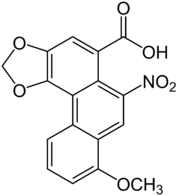- Aristolochic acid
-
Aristolochic acid  8-methoxy-6-nitrophenanthro[3,4-d][1,3]dioxole-5-carboxylic acidOther namesAristolochic acid I
8-methoxy-6-nitrophenanthro[3,4-d][1,3]dioxole-5-carboxylic acidOther namesAristolochic acid I- Aristinic acid
- Aristolochia yellow
- Aristolochic acid A
- Aristolochin
- Aristolochine
- Descresept
- Isoaristolochic acid
- Tardolyt
- TR 1736
Aristolochic acid II
- Aristolochic acid B
Identifiers CAS number 313-67-7 PubChem 2236 ChemSpider 2149 
KEGG C08469 
ChEMBL CHEMBL93353 
Jmol-3D images Image 1 - [O-][N+](=O)c1cc4c(c2c1c(C(=O)O)cc3OCOc23)cccc4OC
- InChI=1S/C17H11NO7/c1-23-12-4-2-3-8-9(12)5-11(18(21)22)14-10(17(19)20)6-13-16(15(8)14)25-7-24-13/h2-6H,7H2,1H3,(H,19,20)

Key: BBFQZRXNYIEMAW-UHFFFAOYSA-N
InChI=1/C17H11NO7/c1-23-12-4-2-3-8-9(12)5-11(18(21)22)14-10(17(19)20)6-13-16(15(8)14)25-7-24-13/h2-6H,7H2,1H3,(H,19,20)
Key: BBFQZRXNYIEMAW-UHFFFAOYAG
Properties Molecular formula C17H11NO7 Molar mass 341.27 g mol−1 Density 1.571g/cm3 Melting point 260 - 265 °C
Boiling point 615.5°C @760mmHg
Solubility in water slightly soluble in water Hazards Flash point 326°C  acid (verify) (what is:
acid (verify) (what is:  /
/ ?)
?)
Except where noted otherwise, data are given for materials in their standard state (at 25 °C, 100 kPa)Infobox references Aristolochic acids are a family of carcinogenic, mutagenic, and nephrotoxic compounds commonly found in the Aristolochiaceae family of plants, including Aristolochia and Asarum, which are commonly used in Chinese herbal medicine.[1] Aristolochic acid I is the most abundant of the aristolochic acids and is found in almost all Aristolochia species.[2] Aristolochic acids are often accompanied by aristolactams.[3]
Aristolochic acids may be a causative agent in Balkan nephropathy.[4][5] Exposure to aristolochic acid is associated with a high incidence of uroepithelial tumorigenesis.[6]
Aristolochic acids are slightly soluble in water, have a melting point between 281 and 286 degrees celsius,[7] and have a bitter flavor.[8]
Contents
See also
- List of herbs with known adverse effects
- Stephania tetrandra
References
- ^ Nolin, Thomas D. & Himmelfarb, Jonathan (2010). "Mechanisms of drug-induced nephrotoxicity". In Uetrecht, Jack. Adverse Drug Reactions. Springer. p. 123. ISBN 9783642006623. http://books.google.com/books?id=0NhAFmL2Q08C&pg=PA123.
- ^ Wu, Tian-Shung et al. (2005). "Chemical constituents and pharmacology of Aristolochia species". In Rahman, Atta-ur. Studies in Natural Products Chemistry: Bioactive Natural Products (Part L). Gulf Professional Publishing. p. 863. ISBN 9780444521712. http://books.google.com/books?id=UBHng8FfwgIC&pg=PA863.
- ^ Wink, Michael & Schimmer, Oskar (1999). "Modes of action of defensive secondary metabolites". In Wink, Michael. Functions of plant secondary metabolites and their exploitation in biotechnology. CRC Press. p. 75. ISBN 9780849340864. http://books.google.com/books?id=eFQgSjZIu8EC&pg=PA75.
- ^ Geacintov, Nicholas E. & Broyde, Suse, ed (2010). "Introduction and perspectives on the Chemistry and Biology of DNA Damage". The Chemical Biology of DNA Damage. Wiley-VCH. p. 7. ISBN 9783527322954. http://books.google.com/books?id=PueBA8SiPdAC&pg=PA7.
- ^ Wild, Chris et al., ed (2008). Molecular epidemiology of chronic diseases. John Wiley & Sons. p. 113. ISBN 9780470027431. http://books.google.com/books?id=w86iv6ib-zcC&pg=PA113.
- ^ Ronco, Claudio et al., ed (2008). Critical care nephrology. Elsevier Health Sciences. p. 1699. ISBN 9781416042525. http://books.google.com/books?id=XkKn96HThzEC&pg=PA1699.
- ^ Barceloux, Donald G. (2008). "Aristolochic acid and Chinese Herb nephropathy". Medical toxicology of natural substances: foods, fungi, medicinal herbs, plants, and venomous animals. John Wiley & Sons. p. 384. ISBN 9780471727613. http://books.google.com/books?id=HWUzlp_V6uIC&pg=PA384.
- ^ Offermanns, S. & Amara, Susan G., ed (2006). Reviews of physiology, biochemistry and pharmacology, Volume 154. Birkhäuser. p. 56. ISBN 9783540303848. http://books.google.com/books?id=2CgsRIL2lGAC&pg=PA56.
Further reading
- Aronson, J.K. (2008). "Aristolochicae". Meyler's side effects of herbal medicines. Elsevier. p. 55. ISBN 9780444532695. http://books.google.com/books?id=ibxfK1l6oXoC&pg=PA55.
- Lai M., 2009. Journal of National Cancer Institute. doi:10.1093/jnci/djp467. (Short summary published as "Chinese herbal products containing aristolochic acid were associated with urinary tract cancer" in "HemOnc today", page 28, dated 2010-01-25.)
- Mills, Simon & Bone, Kerry (2005). "Aristolochic Acid Nephropathy". The essential guide to herbal safety. Elsevier Health Sciences. p. 15. ISBN 9780443071713. http://books.google.com/books?id=85M0N8UioCcC&pg=PA15.
- Wing-Tat Poon, Chi-Kong Lai, Albert Yan-Wo Chan, 2007. "Aristolochic Acid Nephropathy: The Hong Kong Perspective." Hong Kong Journal of Nephrology, 9(1):7-14.
External links
Categories:- IARC Group 1 carcinogens
- Nitro compounds
- Phenol ethers
- Carboxylic acids
Wikimedia Foundation. 2010.
